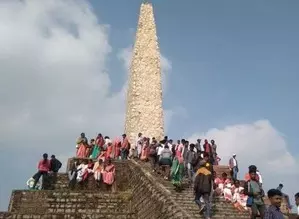Tributes paid to martyrs of Dombari Buru, a bigger massacre than Jallianwala Bagh

Ranchi, Jan 9 The Dombari Buru hill in Jharkhand stands as a solemn reminder of one of the bloodiest massacres during India's freedom struggle. While the Jallianwala Bagh massacre is widely recognized, the tragic events of January 9, 1900, at Dombari Buru were much bigger in scale.
On the 125th anniversary of the massacre, hundreds of people gathered to pay homage at the martyrs' pillar on the hill. The site commemorates the sacrifices of Munda tribals who fought valiantly under the leadership of Birsa Munda, a revolutionary tribal leader who had declared "Abua Raj" (self-rule) in defiance of British authority.
The British, alarmed by the uprising, surrounded the hill and opened fire on the assembled tribals. Armed only with bows and arrows, the Mundas fought back but faced a brutal onslaught. Tribal history scholars estimate over 400 lives were lost, although British records claim only 12 deaths.
Jharkhand Chief Minister Hemant Soren on Thursday paid tribute, stating on social media: "In the fight for India's independence and rights, countless brave men of Jharkhand have sacrificed their lives. However, these sacrifices often remain buried in the pages of history. The Dombari Buru massacre is one such tragic episode, where hundreds of our brave warriors gave their lives to protect Jharkhand's identity, rights, and natural resources. Their sacrifice will never be forgotten. Hundreds of salutes to the immortal martyrs of Dombari Buru."
Study conducted by the Tribal Research Institute (TRI) of the Jharkhand government has shed light on the massacre. A British report claimed 12 deaths, but a 1957 Bihar government report placed the number of deaths at 200. Folklore and stone inscriptions in the region preserve the names of martyrs like Hadi Munda, Majhia Munda, Hopen Manjhi, and others.
These accounts highlight the atrocities, including reports that two of Birsa Munda’s associates -- Hathiram Munda and Singrai Munda -- were buried alive.
According to the research report, British Commissioner A Forbes, Colonel Westmoreland and HC Straitfield led the army that carried out the massacre.
The massacre left Dombari hill drenched in blood, with the nearby Tajna river reportedly turning red.
Despite the British victory, Birsa Munda evaded capture for weeks. He was eventually arrested on February 3, 1900, while asleep in the forests of Chaibasa. Later imprisoned in Ranchi, he passed away under mysterious circumstances on June 9, 1900.
Dombari Buru remains a symbol of the resilience and sacrifice of the tribal community in India’s struggle for freedom.
Source: IANS